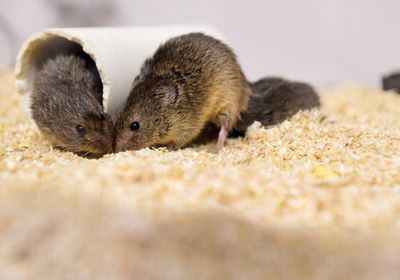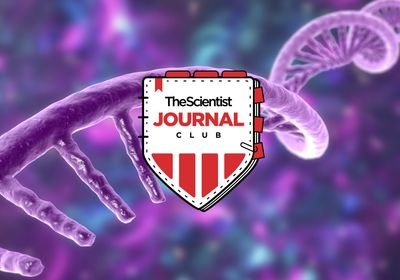ABOVE: Scientists use the socially monogamous prairie voles (Microtus ochrogaster) to investigate the molecular basis of bond formation and disruption. Paul Muhlrad
Losing a partner is a distressing experience for humans. Apparently, that is also the case for prairie voles. These furry little rodents can form lifelong bonds and share parenting and household responsibilities such as defending their underground burrows. Like most people, prairie voles also adapt to the loss of a partner over time,1 suggesting that they might be good models for understanding loss adaptation in the brain.
In a study published in eLife, a research team led by Zoe Donaldson, a neuroscientist at the University of Colorado Boulder, examined prairie vole brains to get insights into the transcriptional changes after bond formation and disruption. They found that pair bonding stimulated the expression of hundreds of genes, and separating the furry couples for weeks, but not days, downregulated this transcriptional signature.2
“There has been some work on partner loss in voles,” said Larry Young, a neuroscientist at Emory University who was not involved in the research. “This is the first time researchers looked at changes in gene expression.”
See “Monogamous Rodents Don’t Need “Love Molecules” To Pair Up”
To investigate the effects of partner loss in the brain, Donaldson and her team housed vole couples together for two weeks and then separated some of the mating couples for either two days or four weeks. They selected those time points since their previous work suggested that voles can form a new bond after a four-week breakup.1
The team first looked at the behavioral effects of partner separation through an experiment in which a vole must choose between spending time with its partner or a stranger. Neither the brief nor long separation altered the voles’ preferences for their partners, suggesting that this core feature of the relationship remains intact despite the physical separation.
It would be wonderful if, as a society, we got better at sort of learning what loss looks like, what grieving looks like, and how to help those people who are grieving.
—Zoe Donaldson, University of Colorado Boulder
The researchers next investigated gene expression changes after partner separation using RNA sequencing. They focused on the nucleus accumbens, a brain region implicated in romantic relationships and grieving in humans. Pair-bonded voles showed stable upregulation of several genes involved in many different brain processes, such as the formation of synapses and signaling pathways relevant for learning. The team found that this upregulation trend was reversed in animals separated for four weeks.
Many of the pair bonding upregulated genes were associated with glial cell functioning. “We didn’t anticipate the role of glia in this process,” said Julie Sadino, a postdoctoral researcher in Donaldson’s group and coauthor of the study. Young found these glial findings enlightening as they suggest that glia, which are often seen as neurons’ helpers, might have a big role in bond formation between couples.
In neurons, the team also found upregulation of genes associated with the dopaminergic system, which is implicated in the control of reward seeking behaviors but only after the brief separation. “This suggests that there may be some withdrawal process happening, some motivational aspect or some frustration resulting from wanting to be with the partner and not being able to,” said Donaldson.
See “Animal Divorce: When and Why Pairs Break Up”
According to Young, one limitation of the study is that the researchers cannot differentiate the types of cells in which these gene expression changes happened as they used a bulk RNA-seq instead of single cell sequencing. He also pointed out that looking at other brain regions connected to the nucleus accumbens is a relevant next step to get a better understanding of pair bond formation and loss at a brain network level.
Donaldson believes that there is still a lot more to learn about the biological basis of grieving and successful adaptation to loss. “There haven’t been many studies, but it is also that societally, we do a really bad job for people when they’re grieving,” she said. “It would be wonderful if, as a society, we got better at sort of learning what loss looks like, what grieving looks like, and how to help those people who are grieving.”
References
- Harbert KJ, et al. How prior pair-bonding experience affects future bonding behavior in monogamous prairie voles. Horm Behav. 2020; 126:104847.
- Sadino JM, et al. Prolonged partner separation erodes nucleus accumbens transcriptional signatures of pair bonding in male prairie voles. Elife. 2023; 12:e80517.





